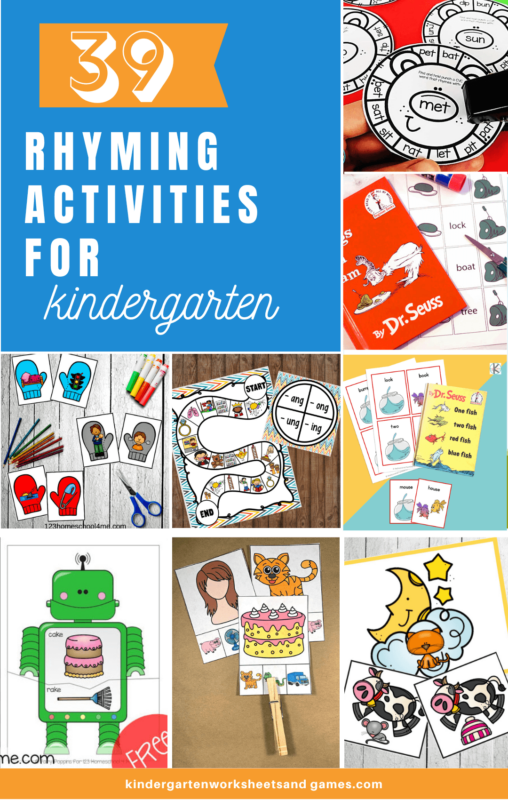Are you wonderingwhat is rhymingor whyteaching rhymingis important for young learners?
Teaching Rhyming
There is something undeniably special about rhymes.
Kids are attracted to the rhythm and flow of rhyming words from a very young age.

Rhymes make learning fun, and they can help kids develop critical early literacy skills.
This post will explore the importance of rhymes and rhyming activities for young learners.
I grew up with nursery rhymes and silly rhyming songs.

As a child, I loved the way rhyming words sounded together.
This post will dive into why rhyming is essential for young learners.
First things first, lets start with the basics.

What is Rhyming?
There is something special about the way rhyming words sound together.
They are fun to say and have a certain rhythm and flow that can be very satisfying.

This is fortunate because rhyming activities are essential to childrens development.
Ready to find out why?
Why Is Rhyming Important?

Did you realize that rhyming activities are important for childrens development?
Keep reading to find out more!
Today we will explore some crucial ways rhyming can help young learners.

This is an important building block for learning to read and write.
Phonemic awareness involves hearing and manipulating individual sounds in spoken language.
Rhyming activities invite children to listen for the sounds in words and play with them.

When rhyming, children must focus on the sounds in words rather than just the meaning.
They realize that cat, hat, mat, and rat all end with the AT sound.
Rhyming is a fun and easy way for young children to explore language.

They start to learn about different word families and sounds without even realizing it.
Then they can move on to hug, jug, and dug.
This knowledge gives them the confidence they need to succeed as readers.

Furthermore, when you read a childrens rhyme, you might notice that the sounds jump out at you.
Thats because rhymes are organized around similar sounds, which doesnt happen in everyday speech.
We dont normally speak in rhyme.

As a result, rhymes can be a powerful tool for helping your child learn to read.
Repetition of rhymes and stories teaches children how language works.
It also improves
Because these verses are made up of patterns, they are easy first memorization pieces.

Plus, theyre just plain fun!
So next time youre looking for a way to engage your childs mind, try some rhyming activities.
Rhyming Promotes Language Development
Rhymes can be a powerful tool for promoting language learning in young children.

When you recite rhymes to children, they hear how vowels and consonants are combined to form words.
Slowly children begin to understand the building blocks of language.
In addition, rhymes teach things like cadence, volume, voice inflection, pitch, and rhythm.

All these skills are helpful for language development.
Nursery rhymes and rhyming stories are a fun way for children to learn new vocabulary words.
Rhymes frequently introduce youngsters to uncommon words, thus broadening their vocabularies.

Little Miss Muffet, for example, includes words such as tuffet, curds, and whey.
Children love to act out nursery rhymes or do fingerplays.
This helps them learn how and when to use these new-found words.

As your children learn new vocabulary, they will begin to anticipate the word that comes next.
Try pausing before those rhyming words and looking at your child.
It wont be long before they fill in the missing word.

Sometimes they may even create an alternative rhyme.
What About Other Rhyming Benefits?
We have been looking at some cognitive and educational benefits of rhymes and rhyming activities.

Now we want to touch on a few other things that rhyming helps with.
These benefits are mostly tied to reciting nursery rhymes or reading rhyming books.
They are an excellent way to encourage self-expression and build confidence.
Most nursery rhymes are easy to learn and can be recited by anyone.
Memorizing and reciting rhymes together is an excellent bonding activity.
Rhymes are so easy to learn that even the youngest child can quickly remember and join in.
The rhymes provide a common ground for communication and interaction and can be enjoyed by people of all ages.
Parents and children can create lasting memories and forge strong bonds as they recite rhymes.
In the classroom, reciting rhymes together develops listening skills and helps children learn how to pay attention.
Plus, rhyming is just plain fun!
And when children are having fun, theyre more likely to be engaged and to participate.
Songs and rhymes provide comforting rhythms in childrens early lives and also expose kids to gorgeous forms of language.
Mem Fox
Rhyming Expands the Imagination
Rhyming songs and poems are a staple of childhood.
But did you know that rhyming can also help to develop a childs imagination?
These experiences will spill over into other play, such as make-believe games.
As a result, exposing children to rhyming songs and poems can be a great way to encourage creativity.
How to teach rhyming words
Readrhyming books!
Play Rhyming games and activities!
(see below)
Complete rhyming worksheets!
(see below)
Rhyming Activities
Looking for more practice rhyming?
Practice does make perfect as the saying goes.
Plus dont miss theserhyming books for kindergarten.
Match the rhyming words
Here are severalrhyming puzzlesthat make practicing matching word that rhyme fun!